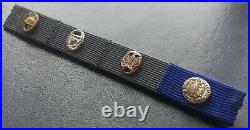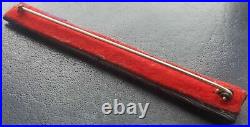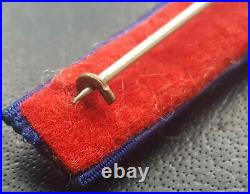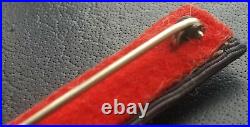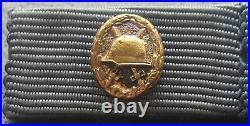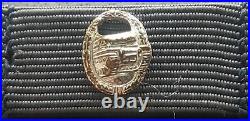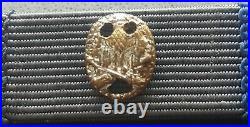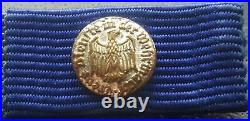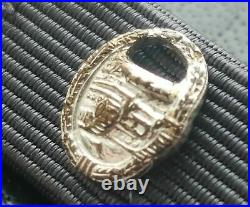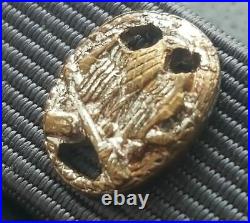Original German post WW2 version / 1957 pattern ribbon bar: Wound Badge in Black, Panzer Badge in Silver, General Assault Badge & Long Service Award for 12 Years’ Service, VERY NICE WORN CONDITION, PERFECT PIN DEVICE, ATTRACTIVE & DETAILED MINIATURES, A REALLY GOOD EXAMPLE. FEW FACTS ABOUT THE 1957 PATTERN AWARDS. In 1957 the West German government authorised replacement Iron Crosses with an Oak Leaf Cluster in place of the swastika, similar to the Iron Crosses of 1813, 1870, and 1914, which could be worn by World War II Iron Cross recipients. The 1957 law also authorised de-Nazified versions of most other World War II-era decorations (except those specifically associated with Nazi Party organizations, such as SS Long Service medals, or with the expansion of the German Reich, such as the medals for the annexation of Austria, the Sudetenland, and the Memel region). The main government contract to manufacture and supply these new de-nazified WW2 1957 official decorations went to the world famous German firm Steinhauer & Lueck, Luedenscheid Germany. Knights Crosses, Iron Crosses, Wound Badges, Tank Assault Badges etc were re-designed by Steinhauer & Lück – often with the oak-leaf spray replacing the swastika, with S&L having the sole patent rights to all WW2 1957 German decorations. S&L did not have the whole monopoly on medal making, other famous firms such as Deschler & Sohn, BH Maher and Juncker also manufactured these new German decorations. Lüdenscheid is situated between the cities Dortmund and Bonn. It was here that one of the youngest medal firms was founded in 1889 by August Steinhauer and Gustav Adolf Lück. The first production began in a cellar, the customer base continued to increase. A property was bought at 51 Hochstrasse which is still home for this famous company today. During WW2 Steinhauer & Lück produced medals and badges, like the famous Knights Cross and many other types of medals and badges. In 1957 this company was awarded the contract to produce all the newly re-designed legal WW2 1957 de-nazified decorations, plus the contract to manufacture all of Germany’s official decorations including Germany’s highest order the Bundesverdienstkreuz. Only a very limited number of original WW2 1957 medals are still produced, mainly Iron Crosses, German Cross Gold & Silver & Wound Badges and are considered 100% genuine by the German Government. HISTORY OF THE AWARD. Wound Badge (German: das Verwundetenabzeichen) was a German military award for wounded or frost-bitten soldiers of Imperial German Army in World War I, the Reichswehr between the wars, and the Wehrmacht, SS and the auxiliary service organizations during the Second World War. After March 1943, due to the increasing number of Allied bombings, it was also awarded to injured civilians. It was ultimately one of the most common of all Third Reich decorations, yet also one of the most highly prized, since it had to be “bought with blood”. The badge had three versions: black (representing Iron), for those wounded once or twice by hostile action (including air raids), or frost-bitten in the line of duty; silver for being wounded three or four times, or suffering loss of a hand, foot or eye from hostile action (also partial loss of hearing), facial disfigurement or brain damage via hostile action; and in gold (which could be awarded posthumously) for five or more times wounded, total blindness, “loss of manhood”, or severe brain damage via hostile action. Badges exist in pressed steel, brass and zinc, as well as some base metal privately commissioned versions. Those of the First World War were also produced in a cutout pattern. All versions of the Wound Badge were worn on the lower left breast of the uniform or tunic. The badge was worn below all other awards on the left. It is thought that more than 5 million were awarded during World War II. In 1957, a revised version of the Wound Badge was authorised for wear; however, the previous type could still be worn if the swastika was removed (for example by grinding). The unaltered Second World War version is shown in the illustration to the right. Wound Badges were primarilly manufactured by the Vienna mint, and by the firm Klein & Quenzer. At first, the Wound badge in Black was stamped from sheet brass, painted semi-matt black, and had a hollow reverse with a needle pin attachment. From 1942, Steel was used to make the badges, which made them prone to rust. The Wound Badge in silver was made (before 1942) from silver-plated brass, and (after 1942) from laquered zinc, and had a solid reverse with either a needle pin or a broad flat pin bar. The Wound Badge in Gold was a gilded version of the Wound Badge in Silver. Heer Panzer Badge (German: Panzerkampfabzeichen) was a German medal awarded to armour troops during World War II. Introduced in World War II in December 1939 (although first introduced during the Great War and another version from the Spanish War). The Tank Combat Badge, or Panzer Badge, first existed in the German Army during World War I, and was later issued again after the Spanish Civil War. The Panzer Badge was introduced on December 20, 1939, in order to recognize the achievements of Panzer personnel who took part in armored assaults. It was designed by Wilhelm Ernst Peekhaus of Berlin, and was instituted by order of Generaloberst Walther von Brauchitsch. On June 6th, 1940, a separate class of the badge, in Bronze, was added in order to recognize the crews of armored vehicles other than tanks. The badge was presented in a paper packet with the name of the award printed on the outside. The award document that was awarded with it was the common type that had the particulars of the recipient (rank, name) and the authorizing signature of an officer. The Panzer Badge was worn on the left tunic pocket. The Bronze Panzer Badge was authorized for armored personnel and Panzer-Grenadier units equipped with armored vehicles. It was also to be presented to members of armored reconnaissance groups and rifle battalions of Panzer divisions. The authorization of these badges was usually done at a regimental or divisional level. The Panzer Badge consists of an oval with a wreath composed of five single oak leaves on one side and four on the other (the tank treads cover one). At the base of the oval is a tie, and on top is the Wehrmacht eagle, which has downspread wings and is clutching a swastika in its talons. In the center of the badge is a tank that passes from left to right. The left track of the tank goes into the wreath of oak leaves, and the area under the tank is grooved and made to look like grass. The reverse of the badge has three variations, the badge could either be hollow backed, flat, or semi-dished. The hollowed backed variation showed the imprint of the obverse, while the flat was just solid (pictured here). The semi-dished version has a slight indent that shows part of the outline of the tank. The badge was attached to the uniform via a hitch and hook, which were affixed to the reverse and had a couple was the conventional soldering of a small rectangular medal bar (pictured here), as well as the more rare type in which a circular ball hinge was inserted into the body of the badge. The tank in the center of the medal is a Panzerkampfwagen IV. Silver Panzer Badge criteria were, to have taken part in 3 armored assaults on 3 different days, to have been wounded in an assault, to have won a decoration for bravery in an assault. The Silver class was presented to tank commanders, gunners or radio operators while the bronze class was presented to the Panzer-Grenadier regiments, tank assault crew, armored recon units, and medical personnel who went into battle in armored vehicles. The award was authorized through the Panzer Division commander. As the war continued it became apparent that the single Panzer Badge was no longer adequate to recognize the growing number of veterans with years of experience, and in June of 1943 four new classes of the award were introduced for 25, 50, 75 and 100 engagements. These new badges consisted of an award that was similar to the unnumbered Panzer Badge, but with a box showing the Arabic number of the class at the base of the wreath. The badge was slightly larger for the 25 and 50 type with the 75 and 100 being larger still. The wreath in the case of the 25 and 50 was silvered, while in the 75 and 100 class it was gilt. The center of the badge (the tank) was made of a separate striking and chemically darkened in the case of the 25 and 50 class, while in the 75 and 100 class the tank was silvered. The reverse has several variations, and could either have a slim or wide pin. The 50 and 100 engagement badges were struck in a in a lightweight zinc alloy, this was so that the larger pin did not pull inconveniently on the tunic. The 200 engagements badge was unofficially created and was never officially documented. The Tank in the center of the medal is a Panzerkampfwagen III. The 1957 de-Nazified version lost the Eagle and the Swastika, but was otherwise unchanged. On November 3, 1944 Reichsmarshall Hermann Göring instituted the Luftwaffe Panzer Badge, to honor the panzer troops of the Luftwaffe field divisions. Until this time qualified Luftwaffe personnel were awarded the Panzer Badge. The order called for two basic forms of the badge. The first style consisted of silver oak leaf wreath and Luftwaffe flying eagle with a black tank in the center. These badges were awarded to tank commanders, gunners, drivers, radiomen, repair crews and their medical personnel. The second style was identical to the first except the oak leaf wreath was now black. Panzer grenadiers, armored reconnaissance units, and the medical personnel attached to them were all eligible for this style. The Luftwaffe Panzer Badge consists of an oval wreath composed of eight oak leaves on the left and, due to the tank protruding from the center, only seven oak leaves on the right. A ribbon is positioned on the base of the wreath and a Luftwaffe flying eagle is to be found at the top. The award document that was to be awarded with it was the common type featuring the recipients name, rank, unit, and the authorizing signature of an officer. The Luftwaffe Panzer Badge was worn on the left pocket of the tunic and (as with all badges) could be worn on civilian clothes in miniature stickpin form. Both badge styles were awarded for three combat engagements on three different days. As mentioned above the silver wreathed versions were awarded to panzer crews, repair crews, and the medical personnel attached to them, while the black wreathed version was awarded to panzer grenadiers, armored recon units, and their medical personnel. General Assault Badge – General von Brauchitsch instituted the General Assault Badge on January 1st, 1940. The badge, designed by the firm of Ernst Peekhaus of Berlin, was to be awarded to those German soldiers who participated in infantry attacks but were not part of infantry units and therefore did not quality for the Infantry Assault Badge. The General Assault Badge consisted of an oval disk that measured 53mm by 42mm and was 6mm wide. The disk had raised edges and fine pebbling in the background, with and wreath of oak leaves made of 5 parts laid on each side. This oak leave wreath begins at two acorns located at the base of the badge. The protruding stick grenade and bayonet separate the first two wreaths, while acorns fill the last two separations. The center feature consists of a Wehrmacht Eagle clutching a swastika in its talons. The eagle surmounts a crossed bayonet and a stick grenade, which as mentioned above protruded into the oval disk. The reverse may either be solid or hollow, with a pin and catch serving as the devise that held the badge to the uniform. As with most badges the quality of detail in the General Assault Badge is mostly standard, but the quality of materials was not always the same and as a result some of the badges have lost their finish with the passing of time, yielding a gray appearance. For more information on the construction of the General Assault Badge please see the Badge Construction Technique page. The award was most often presented in plain paper packets, that varied in colors, with the name of the award printed on the outside, or in a simple cellophane packet. As with most badges, the General Assault Badge was worn on the left breast pocket of the tunic as badge was presented with an award document that had the details of the recipient, but no official mention of the deed that earned the award. The General Assault badge was presented to engineers (who it was originally designed for), as well as members of the artillery, anti-tank, and anti-aircraft units that served along with the infantry in the conduct of an assault. Also eligible were medical personnel who treated battlefield wounded. In addition, the badge was presented for the single-handed destruction of eight tanks or armored vehicles until the institution (in March of 1942) of The Special Badge for Single Handed Destruction of a Tank. Specific criteria was as follows: the recipient must not be eligible for the Infantry Assault Badge, to have taken part in three infantry or armored assaults on three different days, to have taken part in three infantry or armored indirect assaults on three different days, to have been wounded while fulfilling the second or third requirement, to have earned a decoration while fulfilling the second or third requirement. As the war went on, the high command recognized the need for a higher grade of this decoration to be presented to the increasing number of seasoned veterans, and on June 6th 1943, four new grades were introduced. The badge would now be presented to veterans in 25, 50, 75 and 100 classes. The first two are rare but attainable, meaning that they come for sale at regular dealers from time to time, while the latter two are rare in the extreme. The 25 and 50 badge were similar in style, design and construction. They consisted of an oval wreath of oak leaves similar to the unnumbered badge but larger, measuring 58mm by 48mm with a width of 7mm. At the base of the oval is a box, measuring 10mm by 8mm, with another box measuring 8mm by 6 mm inside of it. In the smaller box was the Arabic number “25″ or “50″, depending of course on the grade. The central design was blackened, while the wreath was silvered. The central motive was again the eagle clutching a swastika on its talons, surmounting a crossed grenade and bayonet. This center design has a black oxidized finish, and was from a different striking which was held on the oval by way of four ball rivets. These badges were slightly different than the ones described this case, the oak leaves wreaths constituted the inner and outer edge of the oval that measured 56mm by 49mm, and was 7.5mm in width. The box at the base of the circle measured 10mm by 8mm, but the inner box measured 9mm by 7mm, a slight e the box were the numbers “75″ or “100″, depending on the grade. The central design was the familiar eagle clutching the swastika surmounting the bayonet and grenade. In this case the eagle is slightly larger, and the bayonet and grenade are crossed at a different angle. The central design was blackened, while the wreath was in this case gilded. The eagle and bayonet/grenade are secured onto the oval by four rivets. The numbered awards had the same criteria as the single badge, and was presented in progressive order as the veterans gained more experience. There was retrospective credit given for service in Russia accumulated as follows, eight months service equaled 10 actions, twelve months service equaled 15 actions, fifteen months service equaled 25 actions. Long Service Award (Wehrmacht-Dienstauszeichnungen) – A year after the reinstitution of the draft Germany reinstated the Long Service Awards (March 16th, 1936). All members of the Armed Forces were eligible for the award which was bestowed in five classes; four years, twelve years, eighteen years, twenty five years and fifty years. The four year service medal was mat silver and had on the obverse the Wehrmacht Eagle and the inscription “Treue Diesnste in der Wehrmacht” (Loyal Service in the Armed Forces). On the reverse it bore only the number 4 in the center surrounded by oak leaves. The twelve year award was the same design but slightly larger, in bronze, and with the number “12″ replacing the “4″ on the reverse. Those who served eighteen years were presented a silver Maltese cross featuring the Wehrmacht eagle in the center obverse and the number “18″ on reverse. The same design was maintained for the next and highest class, awarded to those veterans who served twenty five years. The cross in this instance was gold, larger, and naturally had “25″ on the reverse. A special grade for 40 years of service was also approved; This was an oak leaves set which was worn on the ribbon of the 25 years award. All levels of the award were held on blue ribbons with the appropriate branch of service attached to it. It was either the spread wing eagle for the Army and Navy or the flying eagle for the Air Force. Only two long service awards were to be worn at the same time. The 4 and 12 year classes were obviously to be worn together, but once the individual received the 25 year class, he would wear it with the 4 year class, and if the 40 year class were achieved then it would be worn with the 12 year class. The award was worn as part of a group or in the ribbon bar for daily wear. During its early years of existence the award was normally constructed of German silver and heavily plated, but from 1942 on it was made from gold or silver washed zinc. During the last year of the war, presentation of the award ceased. This item is in the category “Collectables\Militaria\World War II (1939-1945)\Medals/ Ribbons”. The seller is “a..anderson” and is located in this country: GB. This item can be shipped worldwide.
- Era: 1945-Present
- Country/ Organization: Germany
- Country/Region of Manufacture: Germany
- Theme: Militaria
- Service: Army
- Conflict: World War II (1939-1945)
- Type: Medals & Ribbons


